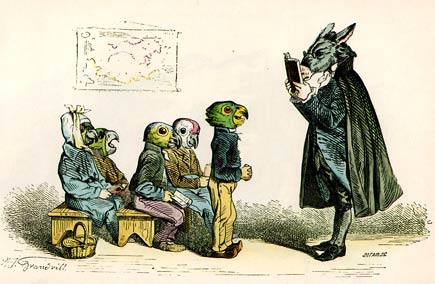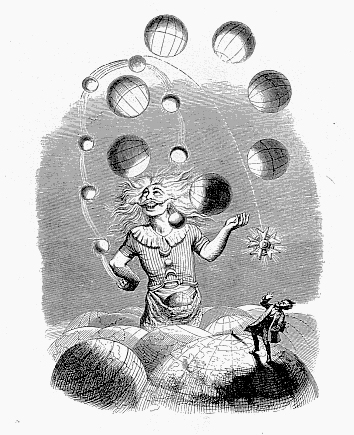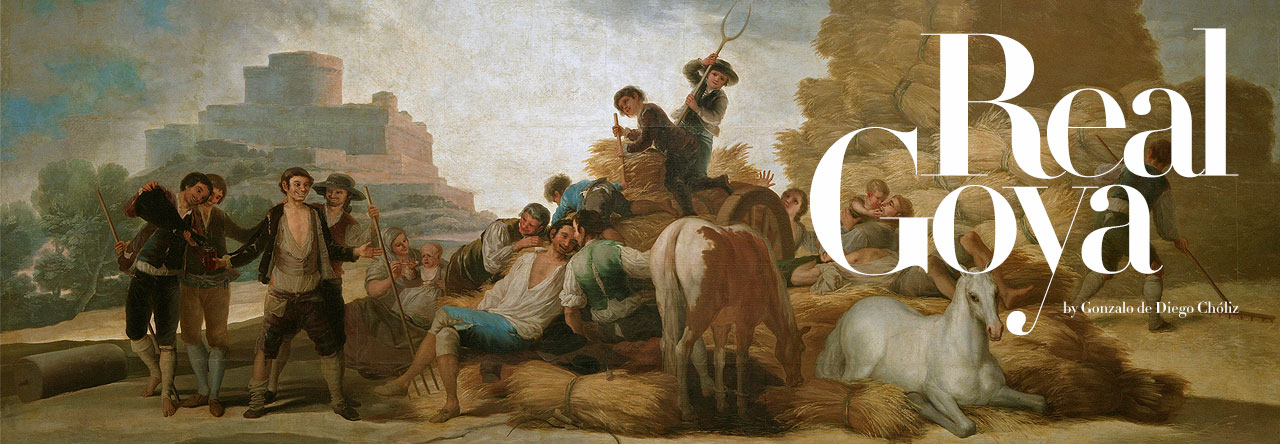The visions and dreams of Goya are a sign of freedom and rebellion in stripe border of creation, subjectivity and Modernity. Goya has with him the only company of the mind and its functions, what means memory, thinking, feelings, imagination and emotions. This is not a few to achieve results that are, in the end, a show off cosmic imagination and fluidity that pour or sprout illuminated and transparent images of someone who expresses interest in the unconscious fairly before than Grandville, for example.
And who was Grandville? And what was his interest in the unconscious? The name “Grandville” was his grandparents professional stage name. Draftsman, watercolorist, caricaturist and lithographer, Jean-Ignace Isidore (Gérard) GRANDVILLE was born on September 15th 1803 in Nancy (France) to an artistic and theatrical family, and died in the asylum of alienated in Vanves (France) on March 17th 1847, at age 43, possibly due to a throat infection.
Related to the genius of Goya, he would be known for their fantastic drawings and satirical cartoons created during the reign of Louis Philippe. Became known in Paris, very young, with the publication of the “Métamorphoses du jour” (Metamorphosis of Today) in 1829. It’s a collection of seventy lithographs of hybrids between humans and animals. In this regard, remember here that the precursor Goya had engraved year’s earlier similar fantasies.

The following year, 1830, Louis Philippe becomes King of France and during the following five years Grandville publish very critical cartoons about the King, by his betrayal to liberals ideal. From November 4th 1830 comes out the magazine “La Caricature”, which under the direction of Charles Philippon, delivers 251 issues up to its latest one on August 27th 1835. Grandville was one of the great illustrators of the magazine and Philippon himself, a large server of current affairs, would entrust him the magazine poster.

Censorship from 1835 will lead Grandville to illustrate books such as editions of “Fables of Lafontaine”, “Gulliver’s Travel” by Jonathan Swift, and the “Robinson Crusoe” by Daniel Defoe.
With great success both critical and audience, between 1840 and 1842 performs his series on “The animals”, with subtitles, which mocks about society and the Government. Though the designs of Grandville are occasionally unnatural and absurd, they usually display keen analysis of character and marvellous inventive ingenuity, and his humour is always tempered and refined by delicacy of sentiment and a vein of sober thoughtfulness. These drawings are remarkable for the extraordinary skill with which human characteristics are represented in animal facial features
However most of young artists, especially the surrealists, found a greater inspiration in the strange Grandville of “Un Autre Monde” (Another World) (1844), a collection of anamorphic drawing full of fantasy in which reverses the relationship between text and illustration. Also in 220 pictures of “Les Metamophoses du Jour” and “Les Fleurs animees” (Animated Flowers) (1847), his dull imagination announces truly precursor signs of contemporary surrealist invention, while Baudelaire called Grandville a “sickeningly literary spirit”.
The first article of Baudelaire on physical states under the influence of hashish, entitled “Du vin et du hashish” (Wine and Hashish), appeared in 1851, but his experiences with opiates and hashish had begun circa 1843, four years before the death of Grandville. Reflection of an era in full mutation, during which the progress of science and industry disrupted livelihoods and the way to represent the world, to Philippe Kaenel “sleep is a hypothesis, because we never know it more than by its memory, but this memory is necessarily a fabrication, an artifice.”
Dr. Moreau de Tours, who Baudelaire regularly visited, concluded that the dream had similarities to delirium and hallucination, and that these three phenomena had been able to relate conscious and unconscious world. Another doctor, Dr. Brière de Boismont, trying to elucidate the functioning of the brain and also wrote about the nightmares and dreams, not only about the hallucinations. His treatise is abundant in cases of singular dreams, among which some had visual similarities with the illustrations by Grandville.
The artistic and literary interests by the unconscious were demonstrating at the same time. In arts, the first example of this new objectivity applied to the study of dreams and the unconscious is seen in the illustrations of Grandville, better known in the years 1830 and 1840 as a cartoonist who was considered to be at the same height as Monnier, Daumier and Gavarni. Very early in his career gave proof of interest in dreams.

Füssli, Goya and Ingres showed the dreamer and the dream vision, the physical presence of the dreamer, as well as his dream. However Grandville breaks with this kind of images and so much in “Un autre Monde” as in “Metamosphose du Sommeil” (Metamorphosis of Dream) do not see more than the same dream, as if we were witnesses of the clinical fact in a succession of randomly associated shapes.
In 1847, year of his death, Grandville published two complex illustrations of the dream in “Le Magasin Pittoresque”. The first, “Crimen et expiation” (Crime and Expiation), tells about the guilt complex. The second, entitled “Promenade dans le ciel” (Ride in the Sky) is less simple to explain, according to the artist himself. Very little is known with regard to these images, and is ignored if the artist dreamed it himself or only built in his imagination.
In a passage located as an appendix to the second dream, Grandville considers the possibility of every day events, or even the blood circulation, affecting to sleep. In this sense, Baudelaire comments on Grandville give to understand that it was in a great propensity for analytical illustrations: “Before he died, applied his will, always stubborn, to record in a plastic form the succession of dreams and nightmares, with the precision of a set designer who writes the speech of a speaker”. The artist Grandville wanted, indeed, the pencil to explain the law of association of ideas…” (Charles Baudelaire in his complete works).
Grandville’s closest friends remembered that in the months preceding his madness and death, in 1847, he had forebodings of his death, dreamt of strange appearances and suffered from hallucinations.
Due to his scientific predilections, we can see on his artwork, not a few, signs of deep familiarity with the investigations of medicine. For example, in the edition in 1838 of the “Voyages of Gulliver” (Gulliver’s Travel), represents an exchange of brains, giving a prelude of a transfer of personality between the two receivers; He thus showed his knowledge of the brain dissections, practiced by the phrenologists. “Le Cauchemar” (The Nightmare) of Grandville is also a proof of his knowledge of the ways dreams lead to feelings of fear or terror: in his dream relives the daytime experiences and shows some common dreams, as the fall on a stairway.
Finally, Grandville illustrations allow measuring both knowledge as the writers on the unconscious in the years 1830 and 1840. Before Courbet show his interest, as later did it at the time that was in Paris with Baudelaire, Grandville was the most curious of this type of reinvestigation artist. But he remained as an illustrator, while working in an environment where to enter such scientific issues. Also Courbet will favor later the appearance of this theme, which will be a key component of the realistic material, into the mainstream of painting. With what the same Courbet seems to point in the direction of the art of Gauguin, Munch, Redon and the Picasso blue and pink, in which the sleepy figures illustrations or going into a trance of dream, the oniric imagination, come to constitute a bigger theme of avant-garde painting general trend.
GdD

Gabriel Alonso Marin
Muy interesante el articulo sobre este artista que sirve de puente entre el mundo de los grabados de Goya y una concepcion mas cirntifica propia del surrealismo. Grandville esta infravalorado por su caracter de “ilustrador” frente a dibujantes mas plasticos de su momento como h Daumier ,y Gustave Dore y no se si por esa cualidad fria y exacta de su estilo de dibujo., tuvo mas influencia en el arte britanico que en el frances.Su influencia en las ilustraciones de “Alicia en el Pais de las maravillas es evidente.
Por otro lado, las ilustraciones del articulo que Le magasin pittoresque dedica a Goya estan firmadas por Grandville